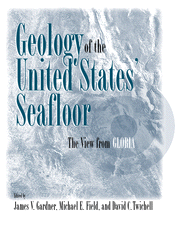Book contents
- Frontmatter
- Contents
- Contributors
- Foreword
- Introduction
- Part I The GLORIA System and Data Processing
- Part II U. S. East Coast EEZ
- Part III Gulf of Mexico and Caribbean EEZ
- Part IV U. S. West Coast EEZ
- Part V Alaskan EEZ
- Introduction
- 15 Sediment Pathways in Gulf of Alaska from Beach to Abyssal Plain
- 16 Sedimentation Along the Fore-Arc Region of the Aleutian Island Arc, Alaska
- 17 Aleutian Basin of the Bering Sea: Styles of Sedimentation and Canyon Development
- 18 Geology of the Kula Paleo-Plate, North Pacific Ocean
- Index
Introduction
Published online by Cambridge University Press: 25 January 2010
- Frontmatter
- Contents
- Contributors
- Foreword
- Introduction
- Part I The GLORIA System and Data Processing
- Part II U. S. East Coast EEZ
- Part III Gulf of Mexico and Caribbean EEZ
- Part IV U. S. West Coast EEZ
- Part V Alaskan EEZ
- Introduction
- 15 Sediment Pathways in Gulf of Alaska from Beach to Abyssal Plain
- 16 Sedimentation Along the Fore-Arc Region of the Aleutian Island Arc, Alaska
- 17 Aleutian Basin of the Bering Sea: Styles of Sedimentation and Canyon Development
- 18 Geology of the Kula Paleo-Plate, North Pacific Ocean
- Index
Summary
Introduction
About 2.7 X 106 km2 of the seafloor of the Bering Sea and North Pacific Ocean were mapped using the GLORIA long-range sidescan sonar system as part of the EEZ-SCAN program of the U.S. Geological Survey (Figure V–I). The areas surveyed include the following: (1) the Bering Sea region, which is all of the Aleutian Basin and Bowers Basin deeper than 200 m east of the U.S. - U.S.S.R. Convention Line of 1867; (2) the Aleutian Arc region, which is the seafloor south of the Aleutian Islands from the insular slope out to the 200 n.m. (370 km) boundary of the U.S. Exclusive Economic Zone (EEZ) and from the 1867 Convention Line eastward to Unimak Pass; and (3) the Gulf of Alaska region, which is that area within 200 nautical miles of the EEZ eastward from Unimak Pass to Dixon Entrance. The Alaskan EEZ survey spanned four years (1986 through 1989) and required twelve cruises each (with one exception) approximately a month in duration. The results of the Bering Sea survey have been published in an atlas (Bering Sea EEZ-SCAN Scientific Staff 1991).
Surveys of the Alaskan EEZ began in 1986 with three cruises to the Bering Sea (Cooper et al. 1986; Gardner et al. 1986; Carlson et al. 1987). A fourth cruise was required in 1987 to complete the area (Cooper et al. 1987).
- Type
- Chapter
- Information
- Geology of the United States' SeafloorThe View from GLORIA, pp. 251 - 254Publisher: Cambridge University PressPrint publication year: 1996



